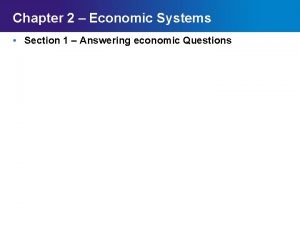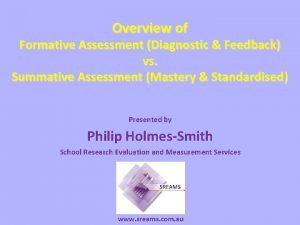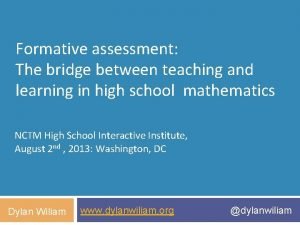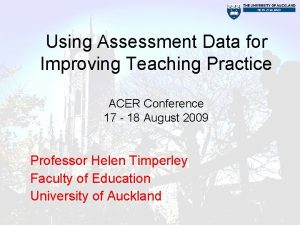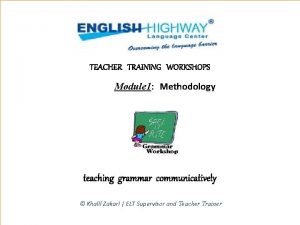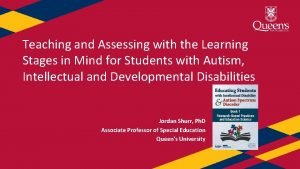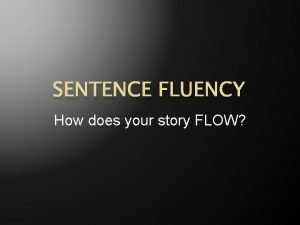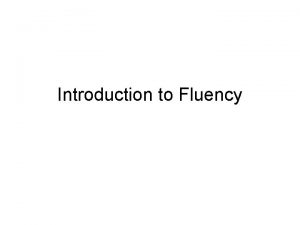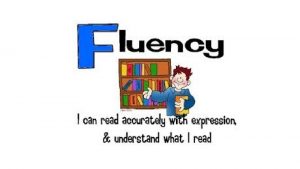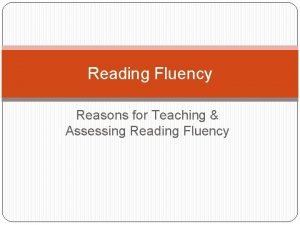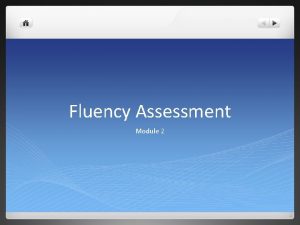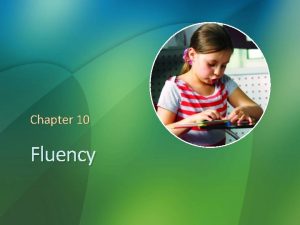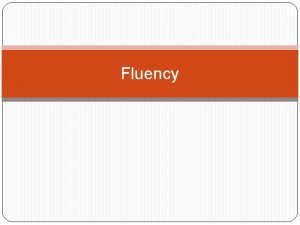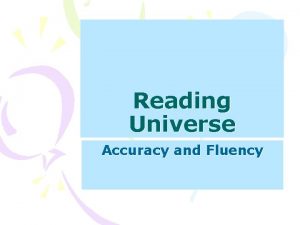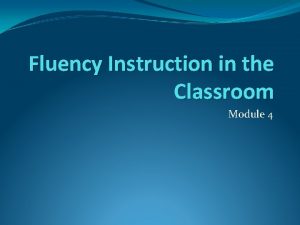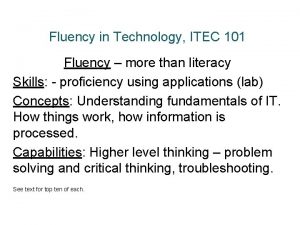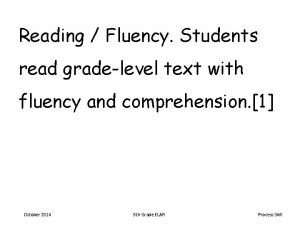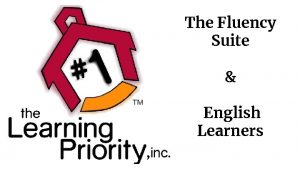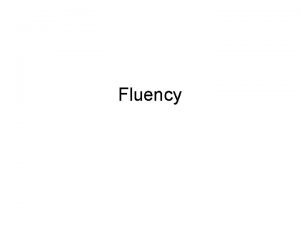Section IV Fluency Chapter 9 Fluency Assessment Teaching























- Slides: 23

Section IV: Fluency Chapter 9: Fluency Assessment Teaching Reading Sourcebook 2 nd edition

Fluency: The Bridge Between Decoding and Comprehension At one end, fluency connects to accuracy and automaticity (rapid word recognition) in Decoding. At the other end, it connects to comprehension through prosody or expressive interpretation.


Fluency: The Bridge Between Decoding and Comprehension l Fluency consists of l accuracy l rate l Prosody l Fluent readers are able to devote their attention to comprehension.

What is Fluency? The ability to read text quickly, accurately, and with proper expression. (The National Reading Panel, 2000) Rapid, efficient, accurate word recognition skills that permit the reader to read with expression and construct meaning. (Pikulski & Chard, 2003)

Fluency is l l l Accuracy: This is the ability to recognize or decode words correctly. Rate: This is the speed or ability to read words automatically, which frees cognitive resources for comprehension. Prosody: They are the features that convey information beyond that provided by the actual words themselves: pitch (intonation, inflection), stress patterns, phrasing (chunking groups of phrases into meaningful units).

Fluency is more than accuracy and rate:

Influences on Reading Fluency • Comprehension: It facilitates fluent reading, especially for beginning or struggling readers. Students read words in meaningful context faster than out of context (word lists). • Automaticity: The proportion of the words recognized instantaneously or by “sight, ” is the most important variable in reading fluency differences. • Speed and Accuracy: Unfamiliar words must be identified analytically using sound/spelling correspondences or “chunks” of words.

Influences on Reading Fluency Continued • • • Metacognition and Purpose for Reading: Students must make decisions or self regulate their rate and prosody, depending on text type. Vocabulary Size: Words that are part of a student’s oral vocabulary are more easily recognized and understood and influence rate and prosody. Motivation and Engagement: Fluency is likely to suffer if a student is not motivated to read or if the text is not engaging.

Fluency Assessment l l l Collecting information about students’ oral reading accuracy, rate, and prosody; Provides an estimate of reading proficiency; Is a strong predictor of success in reading comprehension; Provides information to guide instruction Provides information to improve student outcomes.

Assessment of Oral Reading Fluency l l l The combination of oral reading rate and accuracy is the oral reading fluency (ORF). The assessment tool that is used most for measuring ORF is Curriculum-Based Measurement (CBM). ORF CBM provides a reliable and valid way to: l l identify students who are at risk for reading failure; identify which students are not making adequate progress; identify students’ instructional level for independent reading; identify which students need additional diagnostic reevaluation.

1 -Minute Timed Fluency Assessments What do they tell us? ØHow are they useful? ØWhat do we do next?

Deeper Approaches to Fluency l “Through understanding that readers struggle and why they struggle, we can design appropriate instruction to support students’ developing fluency” (Denney, 2010).

Administering an Oral Reading Fluency CBM Assessment l l l The student reads for one minute from an unpracticed, grade-level passage. The teacher follows along with a copy of the passage and marks any student errors. The ORF is determined by subtracting the number of errors from the total number of words read. This is expressed as words correct per minute (WCPM). To monitor progress, the scores can be recorded on a graph. The graph’s visual form is helpful in interpreting the scores and in helping students see their growth.

DIBELS Oral Reading Fluency

Data-Based Decision Making Pathways of Progress Ø Ø Ø Research-based goal setting tool Meaningful, ambitious, and attainable goals Evaluate individual student progress and rate of growth, compared to other students with the same level of initial skills Evaluate the effectiveness of support at the classroom, school, or district level Not available with survey level progress monitoring

Oral Reading Fluency Performance Expectations l l Compare students’ ORF scores to the National norms: WCPM scores for students by grade level (1 -8) at 3 periods per year. (fall, winter, spring). The norms are listed as percentile scores. (90, 75, 50, 25, and 10) Indicate whether fluency growth meets grade-level expectations or is increasing at a normal rate.

Diagnosis of Dysfluent Reading l l Gathering in-depth information to determine area(s) of weakness. Common causes of dysfluency include: l l l Phonemic awareness, Decoding skills, vocabulary, language syntax, and content knowledge.

Dysfluency and Speed and Accuracy l A “speed-accuracy” trade off occurs when students l l slow down because they are too concerned with accuracy; make many mistakes in an attempt to read text too quickly.

Assessment of Prosodic Reading l l l Prosody is more difficult to measure reliably, but it is often important to assess. To measure prosodic reading, the teacher listens to a student orally read an independent-level passage and then compares the characteristics of the student’s prosodic reading to a rating scale or rubric. Prosodic reading rubrics may include stress, phrasing, intonation, expression, pauses, attention to punctuation, etc.

Multidimensional Fluency Scale

When to Assess l l l Except for first grade, students should be screened at the beginning of the year and monitored three times a year. (fall, winter, and spring) Monitoring for those not making adequate progress should be at least one or two times a month. The average levels of oral reading fluency stabilize at around 150 WCPM for students at the end of 6 th 8 th grades, when reading grade level texts.

Improving Reading Fluency (Pikulski & Chard, 2003; Honig, Diamond & Gutlohn, 2014) l l “Any instruction that focuses primarily on speed with minimal regard for meaning is wrong” (Rasinski, 2012). Read, read, and read some more…WITH varied approaches, an authentic focus on comprehension, and expert teacher guidance: Ø Modeled reading Ø Repeated oral reading Ø Wide independent reading Ø Assisted reading of appropriately selected materials.
 Documentation portfolio example
Documentation portfolio example Portfolio assessment matches assessment to teaching
Portfolio assessment matches assessment to teaching Phases of micro teaching
Phases of micro teaching Chapter 2 section 4 modern economies worksheet answers
Chapter 2 section 4 modern economies worksheet answers Chapter 10 section 1 meiosis worksheet answer key
Chapter 10 section 1 meiosis worksheet answer key Teaching styles self-assessment tool
Teaching styles self-assessment tool Assessment formative summative diagnostic
Assessment formative summative diagnostic Assessment: the bridge between teaching and learning
Assessment: the bridge between teaching and learning Using assessment data for improving teaching practice
Using assessment data for improving teaching practice Btec first engineering teaching and assessment pack
Btec first engineering teaching and assessment pack Teaching and assessment of grammar module 1
Teaching and assessment of grammar module 1 Culturally responsive teaching self assessment
Culturally responsive teaching self assessment Chapter 10 chapter assessment chemical reactions answers
Chapter 10 chapter assessment chemical reactions answers Chapter 11 stoichiometry answer key
Chapter 11 stoichiometry answer key Chapter 9 chemical reactions study guide
Chapter 9 chemical reactions study guide Chapter 9 surface water answer key
Chapter 9 surface water answer key Chapter 2 representing motion chapter assessment
Chapter 2 representing motion chapter assessment The central science 14th edition
The central science 14th edition Chapter 2 standardized test practice answers
Chapter 2 standardized test practice answers Properties of ionic bonds
Properties of ionic bonds Chemistry chapter 7 ionic and metallic bonding
Chemistry chapter 7 ionic and metallic bonding Stages of learning acquisition maintenance generalization
Stages of learning acquisition maintenance generalization Speech emergence examples
Speech emergence examples What is sentence fluency
What is sentence fluency



